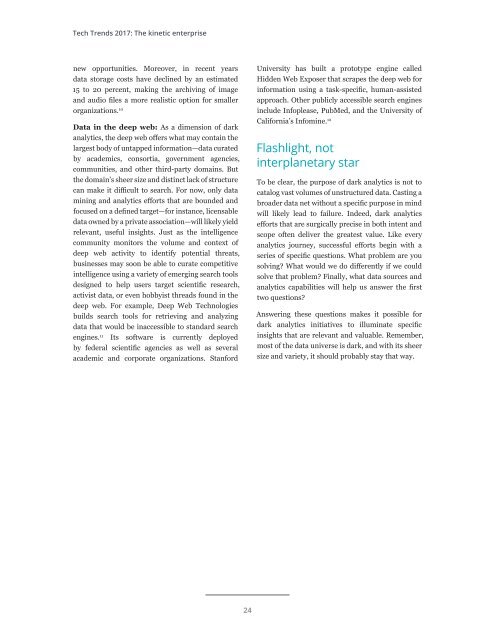Trending the trends Eight years of research
2kcf8xh
2kcf8xh
Create successful ePaper yourself
Turn your PDF publications into a flip-book with our unique Google optimized e-Paper software.
Tech Trends 2017: The kinetic enterprise<br />
new opportunities. Moreover, in recent <strong>years</strong><br />
data storage costs have declined by an estimated<br />
15 to 20 percent, making <strong>the</strong> archiving <strong>of</strong> image<br />
and audio files a more realistic option for smaller<br />
organizations. 10<br />
Data in <strong>the</strong> deep web: As a dimension <strong>of</strong> dark<br />
analytics, <strong>the</strong> deep web <strong>of</strong>fers what may contain <strong>the</strong><br />
largest body <strong>of</strong> untapped information—data curated<br />
by academics, consortia, government agencies,<br />
communities, and o<strong>the</strong>r third-party domains. But<br />
<strong>the</strong> domain’s sheer size and distinct lack <strong>of</strong> structure<br />
can make it difficult to search. For now, only data<br />
mining and analytics efforts that are bounded and<br />
focused on a defined target—for instance, licensable<br />
data owned by a private association—will likely yield<br />
relevant, useful insights. Just as <strong>the</strong> intelligence<br />
community monitors <strong>the</strong> volume and context <strong>of</strong><br />
deep web activity to identify potential threats,<br />
businesses may soon be able to curate competitive<br />
intelligence using a variety <strong>of</strong> emerging search tools<br />
designed to help users target scientific <strong>research</strong>,<br />
activist data, or even hobbyist threads found in <strong>the</strong><br />
deep web. For example, Deep Web Technologies<br />
builds search tools for retrieving and analyzing<br />
data that would be inaccessible to standard search<br />
engines. 11 Its s<strong>of</strong>tware is currently deployed<br />
by federal scientific agencies as well as several<br />
academic and corporate organizations. Stanford<br />
University has built a prototype engine called<br />
Hidden Web Exposer that scrapes <strong>the</strong> deep web for<br />
information using a task-specific, human-assisted<br />
approach. O<strong>the</strong>r publicly accessible search engines<br />
include Infoplease, PubMed, and <strong>the</strong> University <strong>of</strong><br />
California’s Infomine. 12<br />
Flashlight, not<br />
interplanetary star<br />
To be clear, <strong>the</strong> purpose <strong>of</strong> dark analytics is not to<br />
catalog vast volumes <strong>of</strong> unstructured data. Casting a<br />
broader data net without a specific purpose in mind<br />
will likely lead to failure. Indeed, dark analytics<br />
efforts that are surgically precise in both intent and<br />
scope <strong>of</strong>ten deliver <strong>the</strong> greatest value. Like every<br />
analytics journey, successful efforts begin with a<br />
series <strong>of</strong> specific questions. What problem are you<br />
solving? What would we do differently if we could<br />
solve that problem? Finally, what data sources and<br />
analytics capabilities will help us answer <strong>the</strong> first<br />
two questions?<br />
Answering <strong>the</strong>se questions makes it possible for<br />
dark analytics initiatives to illuminate specific<br />
insights that are relevant and valuable. Remember,<br />
most <strong>of</strong> <strong>the</strong> data universe is dark, and with its sheer<br />
size and variety, it should probably stay that way.<br />
24


